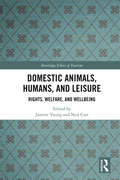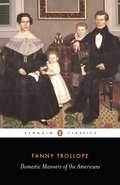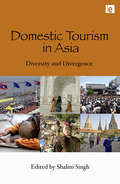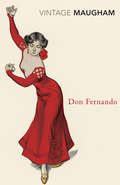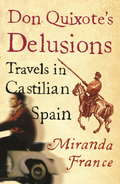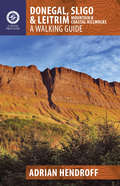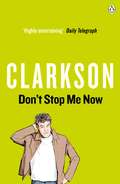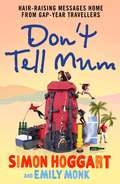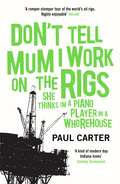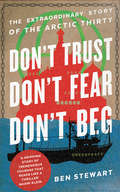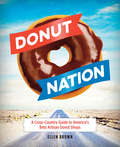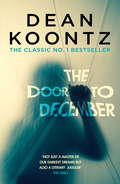- Table View
- List View
Domestic Animals, Humans, and Leisure: Rights, Welfare, and Wellbeing (Routledge Research in the Ethics of Tourism Series)
by Janette Young Neil CarrDomestic animals are an integral component of human leisure experience and can enhance the physical, social, and mental wellbeing of humans. The interplay of human and animal experiences of justice, wellbeing, rights, and roles within leisure is the central theme of this book. Research explores the position of domesticated animals in human leisure experiences, in a wide array of leisure settings. Chapters question whether domestic animals may have a desire for leisure that is different from human leisure, whether animals have and wish to fulfil needs for meaningful leisure or non-leisure, and whether human leisure needs and desires may coincide or contradict wellbeing interests of animals. This book provides a venue for the dissemination and exploration of research, which champions the welfare and rights of these animals to have their needs and interests in leisure recognised. It moves the debate about animals in leisure beyond the current limits which have seen research mainly confined to the exotic ‘other’ rather than more mundane, everyday domestic animals. This book will be of interest to individuals in the fields of tourism ethics, zoology, animal behaviour, and leisure studies.
Domestic Animals, Humans, and Leisure: Rights, Welfare, and Wellbeing (Routledge Research in the Ethics of Tourism Series)
by Janette Young Neil CarrDomestic animals are an integral component of human leisure experience and can enhance the physical, social, and mental wellbeing of humans. The interplay of human and animal experiences of justice, wellbeing, rights, and roles within leisure is the central theme of this book. Research explores the position of domesticated animals in human leisure experiences, in a wide array of leisure settings. Chapters question whether domestic animals may have a desire for leisure that is different from human leisure, whether animals have and wish to fulfil needs for meaningful leisure or non-leisure, and whether human leisure needs and desires may coincide or contradict wellbeing interests of animals. This book provides a venue for the dissemination and exploration of research, which champions the welfare and rights of these animals to have their needs and interests in leisure recognised. It moves the debate about animals in leisure beyond the current limits which have seen research mainly confined to the exotic ‘other’ rather than more mundane, everyday domestic animals. This book will be of interest to individuals in the fields of tourism ethics, zoology, animal behaviour, and leisure studies.
Domestic Manners of the Americans (Mobi Classics Series)
by Fanny Trollope Pamela Neville-SingtonWhen Fanny Trollope set sail for America in 1827 with hopes of joining a Utopian community of emancipated slaves, she took with her three of her children and a young French artist, leaving behind her son Anthony, growing debts and a husband going slowly mad from mercury poisoning. But what followed was a tragicomedy of illness, scandal and failed business ventures. Nevertheless, on her return to England Fanny turned her misfortunes into a remarkable book. A masterpiece of nineteenth-century travel-writing, Domestic Manners of the Americans is a vivid and hugely witty satirical account of a nation and was a sensation on both sides of the Atlantic.
Domestic Tourism in Asia: Diversity and Divergence
by Shalini SinghMany countries have a rich tradition of domestic travel and holidaying which not only predates but exceeds mass international travel. This is particularly the case in Asia where recent economic prosperity and trends in globalization have not merely spurred, but continue to shape traditions in domestic tourism. This book is the first to address specifically the continuities and changes in domestic tourism in Asia. It explores the ethos of domestic travel and holiday-making in order to understand the distinctive common strands that underlie conventional and contemporary tourism practices, against the local and global backdrop. A considerable range of countries is covered in the case studies, including those with patrimonial histories, namely China and India, the economically developed nation-state of Japan and the microstates of Taiwan, Singapore, Macao and Hong Kong, besides the coastal countries of Malaysia, Philippines, Laos and Vietnam, as well as the land-locked countries of Kyrgyzstan and Mongolia. The book presents some of the many interfaces of Asian cultural and natural heritages with tourism, while giving due considerations to today's political and economic realities.
Domestic Tourism in Asia: Diversity and Divergence
by Shalini SinghMany countries have a rich tradition of domestic travel and holidaying which not only predates but exceeds mass international travel. This is particularly the case in Asia where recent economic prosperity and trends in globalization have not merely spurred, but continue to shape traditions in domestic tourism. This book is the first to address specifically the continuities and changes in domestic tourism in Asia. It explores the ethos of domestic travel and holiday-making in order to understand the distinctive common strands that underlie conventional and contemporary tourism practices, against the local and global backdrop. A considerable range of countries is covered in the case studies, including those with patrimonial histories, namely China and India, the economically developed nation-state of Japan and the microstates of Taiwan, Singapore, Macao and Hong Kong, besides the coastal countries of Malaysia, Philippines, Laos and Vietnam, as well as the land-locked countries of Kyrgyzstan and Mongolia. The book presents some of the many interfaces of Asian cultural and natural heritages with tourism, while giving due considerations to today's political and economic realities.
Don Fernando (Works Of W. Somerset Maugham)
by W. Somerset MaughamConsidered by Graham Greene to be Maugham's best work, Don Fernando is a paean to a golden age of enormous creative energy. It discusses the writings of St. Teresa and the paintings of El Greco, and comments with sagacity and wit on such illustrious figures as Cervantes, Velazquez and the creator of Don Juan. This vibrant assessment of a great people at their greatest hour is full of happy surprises, curious facts and stimulating opinions that reflect Maugham's lifelong enchantment with the landscape and people of Spain.
Don Quixote's Delusions: Travels in Castilian Spain
by Miranda FranceA humorous and affectionate look at modern Spain, and a celebration of the country's greatest book, from the pen of a brilliant young writer.When in 1987 Miranda France spent a year living in Madrid, the post-dictatorship ebullience was at its height. Pornography and soft drugs were legalised alongside more basic freedoms, such as divorce, party-affiliation and kissing in the street. In 1998 she returned to make a journey through the great cities and towns of central Spain - Madrid, Toledo, Segovia, Salamanca and others. With the new prosperity, much has changed. But much has also endured, as she learns from the people she meets, who include a private detective, a shepherd, various nuns, two belly dancers and a Castilian separatist. She also discovers that Cervantes' DON QUIXOTE' published in 1605 and the most translated book after the Bible - is a work of genius which still helps to explain the Spanish character: today's Spaniards still suffer from Don Quixote's delusions, and are as stubborn, inflexible and unrealistic as they have always been.
Donegal, Sligo & Leitrim: A Walking Guide (A Walking Guide)
by Adrian HendroffThe northwest of Ireland provides a diversity of walks, from the wild, untamed landscape of Donegal to the gentler hills and green valleys of Sligo and Leitrim. This guidebook describes 27 walks of various grades, accompanied by quality photographs and specially drawn maps. Walk descriptions also include material on the rich natural history, folklore, geology and place names of the area. Since most routes are not signposted or waymarked, an up-to-date guidebook is essential. This will inspire you to get your walking boots on and start exploring this majestic landscape. • Also by this author: 'The Dingle Peninsula: A Walking Guide' and 'The Beara & Sheep's Head Peninsulas: A Walking Guide'. For a complete list of walking guides available from The Collins Press, see www.collinspress.ie
A Donkey in the Meadow: Tales from a Cornish Flower Farm (Minack Chronicles #4)
by Derek TangyeThe fourth title in the Minack Chronicles tells the story of how Derek and Jeannie acquired two donkeys, Penny and Fred. From the first steps and learning all about donkey foibles, through to picnics in the meadows, this is a further charming instalment in the tales of the Tangye's life at Minack.
Don't Look Behind You!: True Tales of a Safari Guide
by Peter AllisonJoin a top safari guide for hair-raising and hilarious tales of South Africa, animals and close escapes.It shouldn't be fun to be charged by an animal that could easily crush you, but top safari guide Peter Allison gets an odd thrill every time an elephant charges his beaten-up Jeep or a peckish crocodile looks at him sideways. By now you'd think the bestselling author of DON'T RUN, Whatever You Do would know how to keep out of trouble. But from avoiding territorial hippos and hungry lions to dodging landmines and getting lost on the unforgiving savannah, Peter has had his fair share of close calls. Drawing on his experiences in South Africa, Botswana, Mozambique and Namibia, Don't Look Behind You! is another book of funny, true safari stories, perfect for telling around a campfire.
DON'T RUN, Whatever You Do: My Adventures as a Safari Guide (G - Reference, Information And Interdisciplinary Subjects Ser.)
by Peter AllisonThe Okavango Delta, Botswana: a lush wetland in the middle of the Kalahari desert. Aged 19, Peter Allison thought he would visit for a short holiday before going home to get a 'proper job'. But Peter fell in love with southern Africa and its wildlife and before long had risen to become a top safari guide.In Don't Run, Whatever You Do, you'll hear outrageous-but-true tales from the most exciting safaris. You'll find out when an elephant is really going to charge, what different monkey calls mean and what do in a face off with lions. Sometimes the tourists are even wilder than the animals, from the half-naked missing member of the British royal family to the Japanese amateur photographer who ignores all the rules to get the perfect shot.Don't Run, Whatever You Do is a glimpse of what the life of an expert safari guide is really like.
Don't Stop Me Now
by Jeremy ClarksonJeremy Clarkson puts the pedal to the floor in Don't Stop Me Now; a collection of his Sunday Times motoring journalism. There's more to life than cars. Jeremy Clarkson knows this. There is, after all, a whole world out there just waiting to be discovered. So, before he gets on to torque steer and active suspension, he takes time out to consider: • The madness of Galapagos tortoises • The similarities between Jeremy Paxman and AC/DC's bass guitarist • The problems and perils of being English • God's dumbest creation Then there are the cars: whether it's the poxiest little runabout or an exotic, firebreathing supercar, no one does cars like Clarkson. Unmoved by mechanics' claims and unimpressed by press junkets, he approaches anything on four wheels without fear or favour. What emerges from the ashes is rarely pretty. But always very, very funny. Praise for Jeremy Clarkson: 'Brilliant . . . laugh-out-loud' Daily Telegraph 'Outrageously funny . . . will have you in stitches' Time Out Number-one bestseller Jeremy Clarkson writes on cars, current affairs and anything else that annoys him in his sharp and funny collections. Born To Be Riled, Clarkson On Cars, Don't Stop Me Now, Driven To Distraction, Round the Bend, Motorworld, and I Know You Got Soul are also available as Penguin paperbacks; the Penguin App iClarkson: The Book of Cars can be downloaded on the App Store. Jeremy Clarkson because his writing career on the Rotherham Advertiser. Since then he has written for the Sun and the Sunday Times. Today he is the tallest person working in British television, and is the presenter of the hugely popular Top Gear.
Don't Tell Mum: Hair-raising Messages Home from Gap-year Travellers
by Emily Monk Simon HoggartSunday Telegraph Humour Book of the Year Hilarious - Daily MailA hilarious and invaluable insight for gap-year travellers into what to avoid out there.The email home is an essential part of every gap-year traveller's journey. Where once the news of narrowly surviving a bus crash on the dirt-roads of India, waking up to gunfire in Honduras or fending off marriage proposals from complete strangers would have made it home only on the back of a slow-moving battered postcard, these days those tantalizing details and terrible mistakes are now recorded immediately and distributed liberally for every friend and family member to wince at.In Don't Tell Mum, Simon Hoggart and Emily Monk have collected together the funniest, most surreal, most alarming gap-year emails into a treasure-trove of correspondence. Accompanied by their wicked commentary, Don't Tell Mum gives the aspiring traveller the low-down on what not to do when trotting the globe.Simon Hoggart's two previous bestselling books: The Cat that Could Open the Fridge and The Hamster that Loved Puccini.
Don't Tell Mum I Work on the Rigs: (She Thinks I'm a Piano Player in a Whorehouse)
by Paul CarterA take-no-prisoners approach to life has seen Paul Carter heading to some of the world's most remote, wild and dangerous places as a contractor in the oil business. Amazingly, he's survived (so far) to tell these stories from the edge of civilization. He has been shot at, hijacked and held hostage; almost died of dysentery in Asia and toothache in Russia; watched a Texan lose his mind in the jungles of Asia; lost a lot of money backing a scorpion against a mouse in a fight to the death, and been served cocktails by an orangutan on an ocean freighter. And that's just his day job. Taking postings in some of the world's wildest and most remote regions, not to mention some of the roughest rigs on the planet, Paul has worked, got into trouble, and been given serious talkings to, in locations as far-flung as the North Sea, Middle East, Borneo and Tunisia, as exotic as Sumatra, Vietnam and Thailand, and as flat-out dangerous as Columbia, Nigeria and Russia, with some of the maddest, baddest and strangest people you could ever hope not to meet.
Don't Trust, Don't Fear, Don't Beg: The Extraordinary Story of the Arctic Thirty
by Ben StewartThere is a saying in Russian jails. Ne ver ne boysya ne prosi: don't trust, don't fear, don't beg. Don't trust because life here will always disappoint you. Don't fear because whatever you're scared of, you are powerless to prevent it. And don't beg because nobody ever begged their way out of a Russian prison cell.The plan was to attach a Greenpeace pod to Gazprom's platform and launch a peaceful protest against oil being pumped from the icy waters of the Arctic. However, heavily armed commandos flooded the deck of the Arctic Sunrise and the Arctic Thirty began their ordeal at the hands of Putin's regime. Told in the activists' own words and for the first time, this is a dramatic and inspiring story of incarceration and the ensuing emotional campaign to bring the protestors home.
Donut Nation: A Cross-Country Guide to America's Best Artisan Donut Shops
by Ellen BrownDonuts are America's favorite treat and, in Donut Nation, Ellen Brown travels the United States in search of the best donut shops. From beloved mom-and-pop establishments and roadside cafes to innovative boutiques and artisanal restaurants, there are more than seventy hand-crafted donut shops to take you from Maine to Arizona. Perfect for the cross-country explorer or home chef, it also includes mouthwatering recipes for donuts like Orange-Pistachio Cake, Maple Bacon, and Strawberry-Buttermilk. Donut Nation is a one-of-a-kind trip to the heart of an American classic.
The Door to December: A terrifying novel of secrets and danger
by Dean KoontzCan the love of a mother bring back the lost past and overcome the terrifying evil of the present? The Door to December is a thrilling novel from bestselling author Dean Koontz, of terrible secrets and a haunting past. Perfect for fans of Richard Laymon and Harlan Coben.'First-rate suspense, scary and stylish' - Los Angeles Times Six years ago, Laura McCaffrey's three-year-old daughter Melanie was kidnapped by Laura's estranged husband, Dylan, and seemingly vanished from the face of the earth.Now, Melanie has been found, a nine-year-old wandering the Los Angeles streets with blank eyes and a secret in her soul she will not or cannot reveal. Dylan has been found too - or at least his mangled remains. Melanie is home again.But can she ever truly be safe - as the floodgates of terror open and the bloody torrent comes pouring through...? What readers are saying about The Door to December: 'Captivating [right up to] the explosive end''Once I started this book I was absolutely hooked and read it in three nights. A fantastic fast-paced thriller''A well written book, the plight of the little girl pulls at your heartstrings, and the tension in the plot keeps you turning the pages'
DOT symbols: bus, ground transportation (Large Print)
by RnibOn this page there are two US Department of Transport (DOT) pictograms used for signage and travel information: a bus pictogram and a ground transportation pictogram. There is a locator dot shown, which will be at the top left of the page when the image is the correct way up. The bus pictogram is at the top centre of the page. It shows a stylised image of a single-decker bus seen from the front. At the top of the image are the buses roof and the destination sign. Down the page is the front widow, two circles representing the front lights and further down, the front wheels. At the bottom centre of the page is the ground transportation pictogram. It consists of an image of a taxi seen from the front on the left and a smaller image of a bus as described above, to the right. At the top of the taxi image is its taxi sign and below this are the front window, two headlights and two front wheels.
DOT symbols: bus, ground transportation (UEB Uncontracted)
by RnibOn this page there are two US Department of Transport (DOT) pictograms used for signage and travel information: a bus pictogram and a ground transportation pictogram. There is a locator dot shown, which will be at the top left of the page when the image is the correct way up. The bus pictogram is at the top centre of the page. It shows a stylised image of a single-decker bus seen from the front. At the top of the image are the buses roof and the destination sign. Down the page is the front widow, two circles representing the front lights and further down, the front wheels. At the bottom centre of the page is the ground transportation pictogram. It consists of an image of a taxi seen from the front on the left and a smaller image of a bus as described above, to the right. At the top of the taxi image is its taxi sign and below this are the front window, two headlights and two front wheels.
DOT symbols: car rental, restaurant (Large Print)
by RnibOn this page there are two US Department of Transport (DOT) pictograms used for signage and travel information: a car rental pictogram and a restaurant pictogram. There is a locator dot shown, which will be at the top left of the page when the image is the correct way up. The car rental pictogram is at the top left of the page. It comprises of a silhouette image of a door key with its blade to the right at the top. Down the page is a stylised image of a car seen from the front. At the top of the car is the windscreen and down the page are the two headlights and two wheels. The restaurant symbol is at the bottom right of the page. It shows a stylised image of a knife and fork. They are seen from above with the forks prongs and the knifes blade to the top of the image. The sharp cutting edge of the knife is to the left.
DOT symbols: bus, ground transportation (UEB Contracted)
by RnibOn this page there are two US Department of Transport (DOT) pictograms used for signage and travel information: a bus pictogram and a ground transportation pictogram. There is a locator dot shown, which will be at the top left of the page when the image is the correct way up. The bus pictogram is at the top centre of the page. It shows a stylised image of a single-decker bus seen from the front. At the top of the image are the buses roof and the destination sign. Down the page is the front widow, two circles representing the front lights and further down, the front wheels. At the bottom centre of the page is the ground transportation pictogram. It consists of an image of a taxi seen from the front on the left and a smaller image of a bus as described above, to the right. At the top of the taxi image is its taxi sign and below this are the front window, two headlights and two front wheels.
DOT symbols: car rental, restaurant (UEB Contracted)
by RnibOn this page there are two US Department of Transport (DOT) pictograms used for signage and travel information: a car rental pictogram and a restaurant pictogram. There is a locator dot shown, which will be at the top left of the page when the image is the correct way up. The car rental pictogram is at the top left of the page. It comprises of a silhouette image of a door key with its blade to the right at the top. Down the page is a stylised image of a car seen from the front. At the top of the car is the windscreen and down the page are the two headlights and two wheels. The restaurant symbol is at the bottom right of the page. It shows a stylised image of a knife and fork. They are seen from above with the forks prongs and the knifes blade to the top of the image. The sharp cutting edge of the knife is to the left.
DOT symbols: car rental, restaurant (UEB Uncontracted)
by RnibOn this page there are two US Department of Transport (DOT) pictograms used for signage and travel information: a car rental pictogram and a restaurant pictogram. There is a locator dot shown, which will be at the top left of the page when the image is the correct way up. The car rental pictogram is at the top left of the page. It comprises of a silhouette image of a door key with its blade to the right at the top. Down the page is a stylised image of a car seen from the front. At the top of the car is the windscreen and down the page are the two headlights and two wheels. The restaurant symbol is at the bottom right of the page. It shows a stylised image of a knife and fork. They are seen from above with the forks prongs and the knifes blade to the top of the image. The sharp cutting edge of the knife is to the left.
DOT symbols: coat check, baggage lockers (UEB Contracted)
by RnibOn this page there are two US Department of Transport (DOT) pictograms used for signage and travel information: a coat check symbol and a baggage lockers pictogram. There is a locator dot shown, which will be at the top left of the page when the image is the correct way up. The coat check symbol is at the top of the page. It is a stylised image of a coat hanger with its hook at the top of the image. The baggage lockers pictogram is at the bottom of the page. At the top of the pictogram is a key with its blade to the right and below this is a rectangle representing a locker. This has a stylised image of a suitcase inside it.
DOT symbols: coat check, baggage lockers (UEB Uncontracted)
by RnibOn this page there are two US Department of Transport (DOT) pictograms used for signage and travel information: a coat check symbol and a baggage lockers pictogram. There is a locator dot shown, which will be at the top left of the page when the image is the correct way up. The coat check symbol is at the top of the page. It is a stylised image of a coat hanger with its hook at the top of the image. The baggage lockers pictogram is at the bottom of the page. At the top of the pictogram is a key with its blade to the right and below this is a rectangle representing a locker. This has a stylised image of a suitcase inside it.
